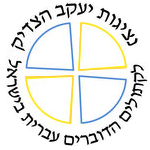Ziv: Parashat BaMidbar 2
Each week, Gad Barnea or Sister Agnès de la Croix (from the Community of the Beatitudes) proposes a reflection on the portion of the Pentateuch that is read in the synagogue (parashat hashavua). This week the portion is from Numbers 1:1 - 4:20 with the haftarah (additional reading) from Hosea 2:1 - 2:22. They call their reflection “ziv” – a ray of light.
![]()
appoint the Levites over the tabernacle
The Book of Numbers, which is called in Hebrew “in the Desert”, and the parasha that bears the same name, begins with a strange verse: “The Lord spoke to Moses in the wilderness of Sinai, in the tent of meeting, on the first day of the second month, in the second year after they had come out of the land of Egypt” (Numbers 1:1). The commentary of Or HaChaim analyses this verse and notes a number of oddities about the verse. First, we already know that the tent of the meeting, Moses and the people are in the wilderness of Sinai - what is the point of repeating this information? Second, the formula for dates in Scripture is usually year, month, day (compare for example Numbers 9:11 or 10:11) - going from the general to the particular - why the deviation from the norm? Finally, even within the verse, if the temporal description goes from the particular to the general, the spatial goes from the general to the particular - from the immense wilderness of Sinai to the tiny tent of the meeting - why the inconsistency?
The Or HaChaim answers: “and it seems that the text purposefully expressed itself in a corresponding manner, and that is on the model of the saying “Behold, there is a place by me” (Exodus 33:21) since the place of the Holy-one blessed be he is secondary to Himself and therefore every space is secondary relative to the place where God dwells and so the flow of generalizations should be understood as going from the tent of meeting to the desert which is secondary to it and it is for this reason that the text placed the form of “the first day of the second month” etc.”
This verse sets up the entire book. It is followed by a census of the children of Israel, among whom the tribe of Levi is not numbered: “But the Levites were not listed along with them by their ancestral tribe. For the Lord spoke to Moses, saying, “Only the tribe of Levi you shall not list, and you shall not take a census of them among the people of Israel” (Numbers 1:47–49). In the second census of the book of Numbers in the plains of Moab thirty eight and a half years later we read a terrible detail: “These were those listed by Moses and Eleazar the priest, who listed the people of Israel in the plains of Moab by the Jordan at Jericho. But among these there was not one of those listed by Moses and Aaron the priest, who had listed the people of Israel in the wilderness of Sinai” (Numbers 26:63–64) - a fate from which the tribe of Levi was exempted since they were not numbered among the first census. The Tribe of Levi is, however, counted apart (Numbers 3:39) and is the smallest tribe of them all. Just like the formula that introduces the book, what seems small is in fact great: what is apparently the smallest tribe will be the only one who survives to the end. Shabbat Shalom.











 Reflecting on Purim and on Lent
Reflecting on Purim and on Lent Rosh HaShana – the Feast of God the Father
Rosh HaShana – the Feast of God the Father Four Words For the Easter Season
Four Words For the Easter Season Ash Wednesday of T. S. Elliot
Ash Wednesday of T. S. Elliot Holy Wednesday
Holy Wednesday Epiphany – the light will conquer the darkness
Epiphany – the light will conquer the darkness